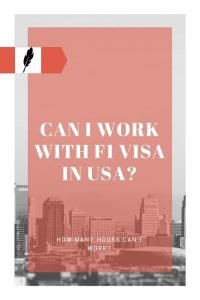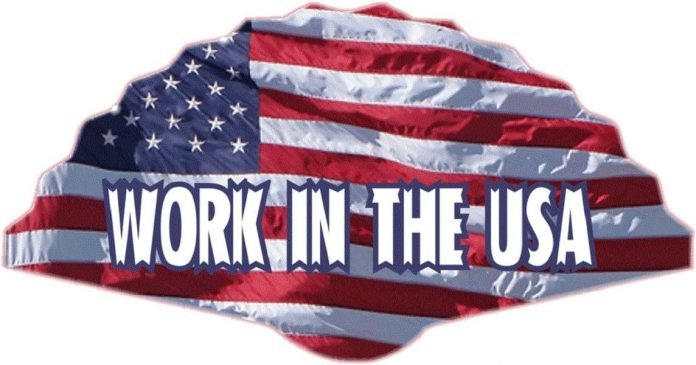Yes, it’s possible to work with F1 Visa in USA. In principle, F1 visa is only for students who are seeking an academic education in USA. However, there are few different opportunities for you to legally work in USA while maintaining your F1 Visa status. Once you finish your studies in USA, you automatically receive one-year work status called Optional Practical Training (OPT). There are also other options such as on-campus, off-campus employments, and Curricular Practical Training (CPT). Also, you can also do alternative methods to increase the years of your work while studying.
SEE ALSO: What type of Visa I need to Study in USA?
First let me start explaining what these 4 traditional methods to work with F1 Visa in USA.
On-Campus Employment
As the Department of Homeland Security states, this type of employment must take a place on campus. The work you are eligible also needs to meet at least one of these criteria:
- Associated with the school’s established curriculum
- Related to contractually-funded research projects at the post-graduate level
Your work hours are limited to 20 hours per week while school continues which is considered as part time work. Typical places for this type of work include library, bookstore, dorm, or cafeteria. Sometimes, professors have ongoing projects partnered with school which can be an opportunity too. You usually need to apply as early as possible and have a good connection with people in your school. To be honest, these jobs are usually taken by locals, so don’t have a huge hope regarding these positions.
Off-Campus Employment

This section only applies to international students who experience specific circumstances. There are number of different reason that could make one qualify for this section. As you all know, when you apply for academic studies in USA, you show a proof of income. So, you can’t just say you don’t have money to support yourself anymore.
SEE ALSO: Top 10 Cheapest USA Destinations for International Students to Travel
However, it is likely to be approved if there is an emergent circumstance that changed your financial status. Department of Homeland Security, provides the information for these circumstances as its stated below:
- Loss of financial aid or on-campus employment (if the student is not at fault)
- Large increases in tuition or living costs
- Substantial decrease in the relative value of currency the student depends upon to pay expenses
- Unexpected changes in the financial conditions for a student’s sources of financial support
- Unexpectedly large medical bills not covered by insurance
- Other substantial, unexpected expenses
In very rare cases, authorities my wave some restrictions for international students which is called Special Student Relief. Although this doesn’t happen very often, we have experienced this when there was tsunami in Japan. Homeland Security allowed Japanese students to work in USA in order to avoid any financial need.
Curricular Practical Training (CPT)
Curricular Practical Training (CPT) is specifically designed to help international students to real-world experience of their field of study. This is why it has to be a part of your school curriculum. It could be an internship program or partnering employer providing practicum for students. The most significant importance of this type of employment is that there is no limit for your weekly work hours. You can even have more than one CPT authorization simultaneously.
However, there is also a trick. If you take a part in CPT for a year or more, you lose your chance of OPT after graduation. In order to meet the requirements for CPT, you must complete one full academic year. If you have already completed one year, consult with your designated school official for the best solution.
Optional Practical Training (OPT)
Optional Practical Training (OPT) is your right to work in your field of study you gain with your F1 visa. Officials provide this opportunity, so you’ll have a chance to experience the work environment in USA. It’s also a unique opportunity to prove yourself to a company for possible status change of your visa. If the company like your work, they can simply sponsor your employment visa and let you stay in the country.
There are two different options for using your Optional Practical Training (OPT):
Pre-completion OPT:
You can use your OPT while still studying. However, you are only allowed work 20 hours per week when school is in session. You can work full time (40 hours per week) when school is not in session.
Post-completion OPT
This is the most common way international students using OPT. Upon completion of their studies, they apply for OPT and receive work authorization for full time.
Tip to Work with F1 Visa in USA for Longer Time

If you break down your studies into half and first apply for Associates Degree, you’ll receive 1-year OPT. You can use this as a pre-completion OPT while obtaining your Associates Degree. Once you are finished with that, you can apply for Bachelor’s Degree and become eligible for one more year OPT. So, you will automatically have 2 years eligibility for work while studying. In this time frame, you can prove yourself to a company to sponsor for your work visa.
SEE ALSO: How to Write a Resume for your First Job Application?
However, do not try using any loopholes as Homeland Security takes work authorization very seriously. You don’t want to take the risk of being deported. They will make sure you are not eligible to study or work in USA for many years or forever. No one would want that in their criminal records.
There are many legal opportunities, use them instead!


